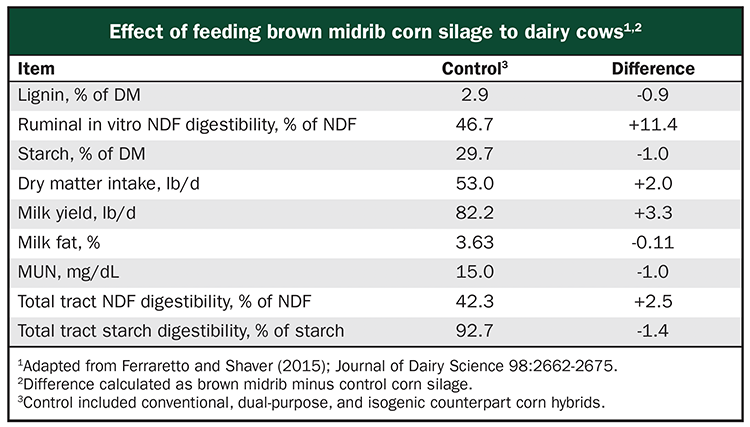The author is an assistant professor and ruminant nutrition extension specialist in the department of animal and dairy sciences at the University of Wisconsin-Madison.
Homegrown forages are vital ingredients in dairy diets with corn silage being one of the anchors in rations for dairy cows. High-quality corn silage not only supplies energy for maintenance — it also fuels lactation in high-producing cows. Coarser corn silage particles, the physically effective fiber, are the foundation of the ruminal mat and stimulate chewing and salivation, rumination, and gut motility and health.
Starch and fiber are the primary sources of energy for dairy cows fed corn silage-based diets. Improvements in the digestibility of these nutrients increase milk production and reduce feed costs through enhanced feed efficiency, particularly when feed prices are high. Let’s dig deeper into the importance of improving fiber digestibility in corn silage.
Limiting factors
Lignin is the key obstacle to fiber digestion because it cannot be digested by rumen microorganisms. In fact, lignin obstructs microbes’ access to cellulose and hemicellulose, the digestible fiber fractions. Due to its importance in animal performance, this association between lignin and other fibrous fractions such as cellulose and hemicellulose is considered in many diet formulation models in use today.
This undigested or indigestible fraction of fiber is estimated using either lignin or quantified as the proportion of neutral detergent fiber (NDF) remaining after in vitro or in situ ruminal incubations such as 240 hours measures undigested neutral detergent fiber (uNDF). Thus, the reduction of lignin or indigestible NDF fractions in corn silage improves fiber digestibility.

Research evaluating the use of uNDF for diet formulation was performed primarily by feeding brown midrib (BMR) corn hybrids. Brown midrib corn hybrids have less lignin and greater fiber digestibility than conventional hybrids. For example, a review of literature comparing BMR with conventional corn hybrids is shown in the table. Briefly, this review highlighted lower lignin concentration (0.9 percentage units) and greater ruminal in vitro NDF digestibility (11.4 percentage units, as a percent of NDF) for BMR than conventional corn hybrids.
Greater fiber digestibility translated into 2 pounds per day more consumption of dry matter (DM) and 3.3 pounds per day more milk. These benefits in performance are associated with reduced gut fill and greater passage rate. These two attributes are magnified when feeding high-forage diets. This concept may be of particular benefit for cows in early lactation when feed intake is limited or during peak lactation when lactation persistency benefits are amplified.
On the flip side, it is important to account for the potential lower yields of BMR hybrids than conventional hybrids when deciding which hybrid to grow. Lower yields may be outweighed by benefits on animal performance, but the magnitude of these responses may vary from farm to farm. Additionally, yield and nutritive value of hybrids varies from year to year and in different regions. Therefore, going through results from hybrid performance trials near your farm and across several years is key prior to implementing new hybrids.
Beyond greater intake
Many factors affect the cow’s ability to produce more milk and milk components. Maximizing consumption of dry matter plays a major role in improving yields. Greater digestibility of corn silage fiber is desired for productivity, profitability, and environmental purposes. Low digestibility promotes rumen fill, restricts consumption, and reduces milk production.
Feeding more digestible corn silage triggers a chain reaction beginning with a faster rumen passage rate and ending with greater milk and components production. Forage particles must sink and undergo particle reduction to leave the rumen. The latter is accomplished through mastication, chewing, and digestion. Corn silage particles of greater fiber digestibility are more fragile and undergo greater and faster particle size reduction.
A greater flow of particles leaving the rumen opens the door for more feed being consumed. Greater intake ensures more energy is available to support milk production, and more digestible feed experiences microbial digestion optimizing microbial protein synthesis and milk protein yield.
More recently, we learned changes in chewing behavior caused by fiber digestibility also play a major role in improving animal productivity and health. Cows fed diets containing less-digestible forage fiber spend more time in the feedbunk to consume similar or lesser amounts of the diet.
Researchers define eating time as the time a cow spends in the feedbunk and likely includes the time eating, masticating, and sorting. More time spent eating equates to reduced animal performance. Cows are likely spending more time masticating or sorting the diet while at the feedbunk and reducing their resting time.
Greater corn silage fiber digestibility improves intake, resting time, and milk production by dairy cows. Reducing the lignin or uNDF concentration of corn silage is key to improving milk and components yield. Feeding reduced-lignin forages, for example brown midrib corn hybrids, to high-producing, early lactation cows and while feeding less digestible conventional hybrids to cows in mid-to-late lactation could be a good strategy to attenuate yield drag issues. Team discussions with nutritionists, agronomists, and crop consultants are advised prior to the establishment of these alternatives.










